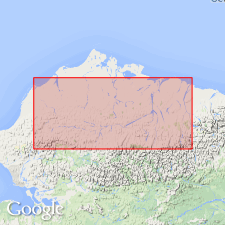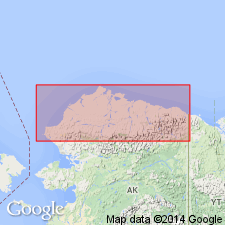
- Usage in publication:
-
- Tuluvak tongue*
- Modifications:
-
- Named
- Dominant lithology:
-
- Sandstone
- Conglomerate
- Shale
- Bentonite
- Coal
- AAPG geologic province:
-
- Alaska Northern region
Summary:
Named as lower tongue (of 2) of Prince Creek formation of Colville group for best exposures at Tuluvak Bluffs on Chandler River, northern AK. Prince Creek formation [and presumably its tongues] are made up of nonmarine sandstone, conglomerate, shale, bentonite and coal. Thickness of tongue at Tuluvak Bluffs is 1200 ft. Overlies Seabee member (new) of marine Schrader Bluff formation (new) of Colville group. Intertongues with Tuluga member (new) of Schrader Bluff formation. Age given as Late Cretaceous.
Source: GNU records (USGS DDS-6; Menlo GNULEX).

- Usage in publication:
-
- Tuluvak tongue*
- Modifications:
-
- Overview
- AAPG geologic province:
-
- Alaska Northern region
Summary:
Measured type section designated at Schrader Bluff, Chandler River region, northern AK. Tongue is 575 ft thick here. Detailed lithology and six other measured geologic sections included in report. Intertongues with marine equivalents, Rogers Creek and Barrow Trail members of Schrader Bluff formation of Colville group. Age is Late Cretaceous on basis of stratigraphic relations.
Source: GNU records (USGS DDS-6; Menlo GNULEX).

- Usage in publication:
-
- Tuluvak Formation*
- Modifications:
-
- Revised
- Age modified
- AAPG geologic province:
-
- Alaska Northern region
Summary:
Pg. 5 (fig. 4), 6-8 (table 1), 20+. Tuluvak Formation. Tuluvak Tongue of Prince Creek Formation of †Colville Group (abandoned) removed from Prince Creek and raised to formation rank. Lower part of formation includes rocks previously assigned to †Ayiyak Member (abandoned) of Seabee Formation. Thickness probably as much as 1,200 feet. Gradationally overlies Seabee Formation (restricted); underlies Schrader Bluff Formation (revised). Fossils. Age is considered Late Cretaceous (Turonian to Coniacian).
Reference sections (partial exposures):
(1) near Ayiyak River, in sec. 31, T. 6 S., R. 3 W. [Chandler Lake D-5 quadrangle, scale 1:63,360, Alaska-North Slope Burough], northern AK;
(2) on Ayiyak Mesa west of the Chandler River, in sec. 25, T. 6 S., R. 1 W. [Chandler Lake D-5 quadrangle, scale 1:63,360, Alaska-North Slope Burough], northern AK; and
(3) between the Nanushuk and Anaktuvuk Rivers, in N/2 sec. 12, T. 7 S., R. 5 E. [Chandler Lake D-2 quadrangle, scale 1:63,360], northern AK.
Source: Publication.
For more information, please contact Nancy Stamm, Geologic Names Committee Secretary.
Asterisk (*) indicates published by U.S. Geological Survey authors.
"No current usage" (†) implies that a name has been abandoned or has fallen into disuse. Former usage and, if known, replacement name given in parentheses ( ).
Slash (/) indicates name conflicts with nomenclatural guidelines (CSN, 1933; ACSN, 1961, 1970; NACSN, 1983, 2005, 2021). May be explained within brackets ([ ]).

